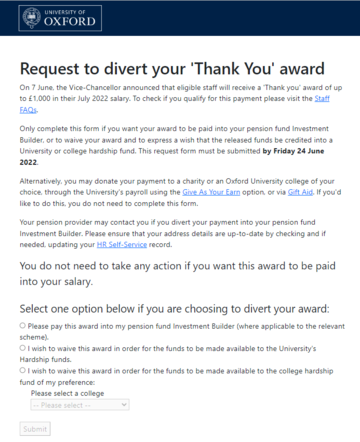Recently, we heard that staff would be receiving a thank you payment from the University. Of course, this meant there was lots of behind the scenes work to get it right, particularly how the payment would be delivered.
While it was agreed that the default option would be to make the payment directly into salaries, further options to divert the payment (either to a pension fund or to a staff hardship fund) were also made available to staff. If opting to divert the payment, staff would need to choose which option they preferred. The HR team quickly realised that this could involve manually going through thousands of emails to find out the choice for each eligible member of staff. This would have been both impractical and very time consuming.

With only a short time available before the message was to be shared with staff, HR contacted the Software Solutions team in IT Services to see if there was a digital solution which could help to make the process of selecting how to receive the payment quicker and easier. This was a high-profile request as the message about the ‘thank you payment’ was being sent by the Vice Chancellor. Also, any eligible staff member would be able to see the form and, if diverting their payment, use it to make their choice – it had to be done properly.
Building a solution
The first challenge was to identify the technical platform that would be best placed to build the solution on. To do this a short competition was run within Software Solutions across the various teams to see who could come up with the best Proof of Concept within one day. The teams looked at various options including AWS, SharePoint, Power Platform, and Office Forms. In the end a form implemented as a custom web application hosted in Microsoft Azure was selected.
Ben Oldfield, who developed the form, told us all about it…
Our solution consisted of a web application which staff would use to make their choice, and which was integrated with University Single Sign-On to identify the person submitting the form. Decisions were then recorded in a small database. As work to confirm requirements was ongoing we needed to keep the solution as flexible as possible, so we created the small web application from scratch, rather than using an out-of-the-box solution. The application and database components were hosted on our Azure Cloud platform, meaning that we would only be charged for the short duration they were needed.

After HR colleagues decided to proceed with our proposal, we adjusted the design and functionality as requirements became clearer. With the help and support of IT Service Desk colleagues, we were able to quickly arrange a temporary mailbox where confirmation emails could be sent. We also worked closely with the Testing Team who advised us on changes we could make to improve accessibility. It was a truly collaborative effort.
While the application was live, we provided regular updates to HR on how many people had completed the form and which payment options had been chosen. It was great to be able to respond quickly to a challenging request, continually adapt our solution, and to deliver something that really helped HR.
Saving time and increasing accuracy
The potential cost - in time and effort – of HR staff manually going through thousands of emails would have been astronomical. The form helped to save both time and money - it also helped with accuracy. In addition, regular updates helped inform decision-making about communications, as well as providing a way to monitor progress.
We caught up with Tonya Iasisen-Kandola in HR who told us:
IT Services showcased their ability to move quickly and get the form up and running by leveraging a combination of cloud hosting and agile working practices. The project was an excellent collaboration between HR and IT Services and showcased what can be done when working together effectively.
We held regular, and in the run-up to ‘go-live’, daily meetings to ensure that everything progressed as expected and any last-minute changes could be smoothly managed. This also enabled a greater understanding of all the requirements as and when these arose, which in turn ensured that everything was well and closely managed by the HR and IT colleagues involved in this piece of work.
The Thank You Payment working group were incredibly impressed by and grateful to Ben Oldfield and Matthew Castle for their efforts in this work.